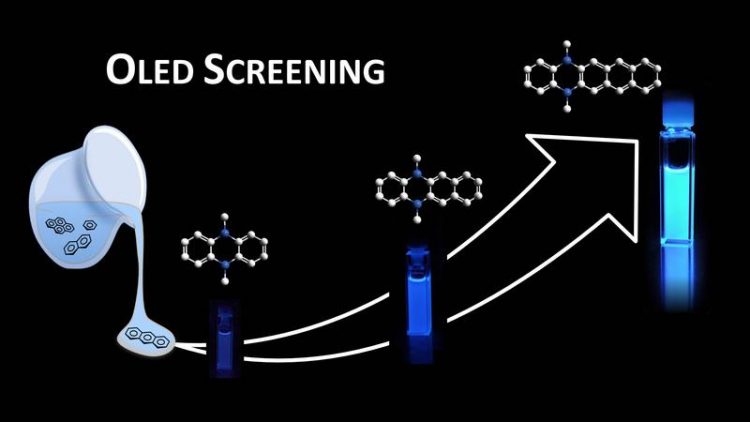Molecular libraries for organic light-emitting diodes

A new screening process means that promising OLED lighting materials can be identified more efficiently. AG Matthias Wagner
The rising demand for increasingly sophisticated smartphones, tablets and home cinemas is a growing challenge for display technology. At present, organic materials are the most effective way to master this challenge.
In particular molecules from the class of materials known as polycyclic aromatic hydrocarbons (PAHs) can be used to produce large and mechanically flexible flat screens. They unite brilliant colours with high resolution and are at the same time low in energy consumption.
Chemists at Goethe University Frankfurt are currently working on new types of organic luminescent materials which owe their particularly promising properties to the introduction of boron atoms into the PAH scaffold.
To date, the syntheses required have been extremely complex and time-consuming. A recently developed screening process, which makes a wide variety of boron-doped PAHs quickly and easily accessible, could in future alleviate this situation. The technique makes it possible to evaluate their potential as OLED materials. Only the most promising candidates will be examined more extensively in the next stage.
As the research group led by Professor Matthias Wagner at the Institute of Inorganic and Analytical Chemistry of Goethe University Frankfurt reports in the scientific journal “Angewandte Chemie”, the method is based on a three-component reaction: Two components remain unchanged in all reactions whilst the third is chosen from a broad range of cheaply available PAHs.
The reactive boron-containing starting material plays an important role in the assembly of the molecular scaffold. In addition, it gives the compounds obtained the desired optoelectronic properties by increasing luminescence and improving the materials’ electrical conductivity.
“For a long time, it has mostly been pharmaceutical research which has profited from screening processes”, says doctoral researcher Alexandra John. “Yet it makes sense precisely in the dynamic and growing field of organic materials to use similar strategies to achieve results in a cost-efficient and resource-friendly way”. Professor Matthias Wagner adds:
“Our development’s market relevance can also be seen by the fact that the Federal Ministry for Economic Affairs and Energy is giving our research work generous financial support.” The funding instrument behind it – WIPANO – supports the transfer of knowledge and technology through patents and norms and aims to ensure the commercial exploitation of innovative ideas and inventions generated by public-funded research by safeguarding and utilizing intellectual property. Wagner and John have already filed a patent for their process.
Media Contact
All latest news from the category: Life Sciences and Chemistry
Articles and reports from the Life Sciences and chemistry area deal with applied and basic research into modern biology, chemistry and human medicine.
Valuable information can be found on a range of life sciences fields including bacteriology, biochemistry, bionics, bioinformatics, biophysics, biotechnology, genetics, geobotany, human biology, marine biology, microbiology, molecular biology, cellular biology, zoology, bioinorganic chemistry, microchemistry and environmental chemistry.
Newest articles

Innovative vortex beam technology
…unleashes ultra-secure, high-capacity data transmission. Scientists have developed a breakthrough optical technology that could dramatically enhance the capacity and security of data transmission (Fig. 1). By utilizing a new type…

Tiny dancers: Scientists synchronise bacterial motion
Researchers at TU Delft have discovered that E. coli bacteria can synchronise their movements, creating order in seemingly random biological systems. By trapping individual bacteria in micro-engineered circular cavities and…

Primary investigation on ram-rotor detonation engine
Detonation is a supersonic combustion wave, characterized by a shock wave driven by the energy release from closely coupled chemical reactions. It is a typical form of pressure gain combustion,…



